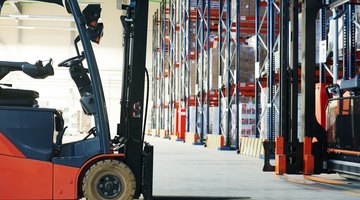How a Forklift Works
Lifting Mechanism: Hydraulic Cylinder Able to lift thousands of pounds, forklifts derive their power from two intertwining mechanisms: a pair of hydraulic cylinders and a pair of roller chain pulleys. The lift handle is wired to an electrical air pump at the base of the machine. When pressed, the handle activates the air pump, which draws in outside air through a filter and forces it into a tube leading to both hydraulic cylinders.
Lifting Mechanism: Hydraulic Cylinder

Able to lift thousands of pounds, forklifts derive their power from two intertwining mechanisms: a pair of hydraulic cylinders and a pair of roller chain pulleys. The lift handle is wired to an electrical air pump at the base of the machine. When pressed, the handle activates the air pump, which draws in outside air through a filter and forces it into a tube leading to both hydraulic cylinders.
A hydraulic cylinder consists of a hollow tube sealed at one end with a movable, lubricated piston fitting into the other. Air enters the bottom of the cylinder through a special "one way" valve that allows gases to enter without leaking back out. As the amount of gas in the cylinder increases, so does the pressure inside it. This pressure, applied across the area of the piston head, results in a net upward force. This upward push causes the piston to move up, which increases the volume of the gas and decreases the pressure. This automatically leads to a physical equilibrium where, at a given lift height, the force from the gas equals the downward force of the forklift's load.
To move the load higher, the operator pushes the handle forward. This signals the machine to pump more air into the cylinders. To lower the load, the operator pulls the handle back, which triggers a special valve to gently release gas from the cylinder.
Lifting Mechanism: Roller Chain Pulley
The hydraulic pistons are attached to the two main vertical structures called the "masts." However, the actual forks that carry the load are attached to the main body of the forklift through a pair of roller chain pulleys whose fulcrum is a gear at the top of the mast.
Thus, when the hydraulic pistons push the masts up, the gears on the masts push against the roller chains. Because one side of the chains are attached to the immobile frame of the forklift, the only way the masts can move up is if the gears rotate clockwise and pull the forks up.
The importance of this mechanism is that it allows the forks go far beyond the reach of the cylinders alone. If it weren't for the roller chain pulleys, forklifts would need much taller cylinders to lift loads to a comparable height. Taller cylinders would mean more building material, which would shift the vehicle's center of gravity forward and increase the risk of tipping. Likewise, taller cylinders would demand stronger pumps and higher pressure thresholds.
Controls
Forklifts have two sets of controls: one for steering and one for lifting. The steering controls work much like those of a golf cart: acceleration pedal, brake, steering wheel, forward gear and reverse gear. However, unlike a car or golf cart, forklifts use rear-wheel steering--when you turn the steering wheel, the wheels on the rear axle turn back and forth. This design is intentional: rear-wheel steering allows the driver a greater degree of rotation and precision when handling a load.
The lifting controls consist of two levers: one for lifting the fork up and down as well as one for tilting the load back and forth. The lifting functionality works as discussed above--forward moves up and backward moves down. The tilting functionality, however, is slightly different. At the base of the masts are two pairs of additional hydraulic cylinders that attach to the base of the vehicle. When the "tilt" handle is moved forward, air is pumped into the chamber. This increase in pressure pushes the piston head and causes the masts to "lean away" from the vehicle's body.
When the "tilt" handle is moved back, air is slowly released from this cylinder as air is pumped into the other pair of mast-attached cylinders. When the pistons from the latter pair push forward, the masts are rocked back toward the vehicle.
References
Writer Bio
A Chicago-based copywriter, Andy Pasquesi has extensive experience writing for automotive (BMW, MINI Cooper, Harley-Davidson), financial services (Ivy Funds, William Blair, T. Rowe Price, CME Group), healthcare (Abbott) and consumer goods (Sony, Motorola, Knoll) clients. He holds a Bachelor of Arts in English from Harvard University but does not care for the Oxford comma.
More Articles



